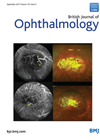
Journal Reviews
A rare case of oculomotor nerve palsy from presumed cavernous angioma
Cavernous angiomas of the cranial nerves are extremely rare, and those of the oculomotor (third) nerve are rarer still. The authors present a single case study of presumed cavernous angioma involving the subarachnoid portion of the left third nerve, which...
EP in a case of abducens nerve palsy
Ecchordosis physaliphora (EP) is a rare non-malignant mass that originates from remains of the notochord and is typically asymptomatic. Symptomatic cases are extremely rare, and the majority are managed by surgical resection. This case study reports a 42-year-old male who...
Hormonal contraceptives and IIH
This multicentre retrospective population based case control study investigated whether there was a higher incidence of idiopathic intracranial hypertension (IIH) in those patients taking oral contraceptive pills (OCP) and other hormonal contraceptives. Fifty-three women were diagnosed with IIH between Jan...
Aberrant regeneration rates following traumatic oculomotor palsy
Traumatic oculomotor nerve palsies can result in aberrant regeneration / synkinesis which impairs normal facial function. In this paper, the authors retrospectively reviewed the records of 16 patients with traumatic oculomotor nerve palsies who were treated with or without steroids....
Using a pupillometer to confirm presence of RAPD in post stroke homonymous hemianopia
It has been reported that relative afferent pupillary defects (RAPDs) may be present in patients with occipital lobe lesions. However, a small contralateral RAPD due to a difference in the crossed and uncrossed fibres can be difficult to detect using...
Use of the RAPDx device to evaluate efficacy of treatment in patients with optic nerve disease
The RAPDx objectively determines the RAPD magnitude by alternately presenting light stimuli to each eye and deriving amplitude and latency scores. The authors of this paper evaluated the amplitude and latency scores from the RAPDx together with other ophthalmic investigations...
Clinical and neuro-ophthalmologic predictors of visual outcome in idiopathic intracranial hypertension
This prospective study of 40 patients aims to assess visual morbidity in patients with idiopathic intracranial hypertension (IIH). Final visual outcome of patients was compared with clinical and neuro-ophthalmic parameters such as visual acuity, visual field, contrast sensitivity, retinal nerve...
Diagnosis of amiodarone-associated optic neuropathy
Amiodarone is a widely used anti-arrhythmic drug. Several case reports describe optic neuropathy which has been linked to its use. This case series discusses the diagnosis of amiodarone-associated optic neuropathy (AAON) and its potential impact on cardiac therapy. The authors...
An atypical presentation of Vogt-Koyanagi-Harada Disease
The authors present a single case of atypical presentation of Vogt-Koyanagi-Harada disease. A 42-year-old female presented with unilateral visual loss associated with systemic symptoms of fever and headache. Initial ophthalmic examination revealed a unilateral neuroretinitis, however, investigations for infectious and...
Overview of traumatic optic neuropathy
The authors present the clinical features and role of various treatment modalities on the final vision outcome in traumatic optic neuropathy (TON). They retrospectively reviewed the records of patients with a diagnosis of TON over a four year period in...
A case of post-viral ocular microflutter
A number of eye movements disrupt visual fixation, one such movement being saccadic intrusions which are described as small involuntary saccadic movements. Among saccadic intrusions without intersaccadic intervals, ocular flutter and opsoclonus are prominent. When the saccadic amplitude is very...
Optic disc haemorrhages as a risk factor for poor outcomes in IIH
This is a report of a review of optic disc photographs, of the type and frequency of the optic disc haemorrhages (ODH), papilloedema grades and other fundoscopic abnormalities at baseline. In the study eyes of 133 patients enrolled in the...








